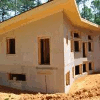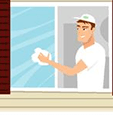
The concepts of Passive solar houses (PassiveHaus) and Passive solar are intermingled, causing confusion and misapplication.
Though they share common points, they do not mean the same. And you should be aware of it.
 German-Style Passive Houses for Cold Climates are Super-Insulated buildings
German-Style Passive Houses for Cold Climates are Super-Insulated buildingsGerman-style passive houses (Passivhaus) rely on extremely high levels of insulation and air-tightness.
Their construction require specific energy calculations and tested standards; they must be designed by a qualified technician and built by trained builders.
See: German-style Passive Solar Houses
Passive solar design principles do not rely necessarily on a super-insulation and air-tightness approach; they do not involve rigid construction standards.
Passive solar design principles were mostly formulated in the 1970s and 1980s and some of them are now being subject to some criticism, especially the advantages of high thermal mass floors and walls and the use of very large glazing areas in the sunny side of the house.
Here are the key principles of Passive Solar design, formulated in a loose and modern way:

Passive Houses (PassiveHaus) do not need large heating and cooling systems.
They rely on high insulation and airtight standards in order to reduce heating needs to very low levels, allowing small (ductless) heating systems.
See: Passive Houses Heating.
 Passive Cooling Do Not Use Air Conditioners
Passive Cooling Do Not Use Air ConditionersPassive cooling relies on breezes, natural ventilation and shading strategies.
See: Passive Cooling Techniques
 Properly Located and Sized Windows
Properly Located and Sized Windows Windows should be planeed (sized and located) according to the climates. In cold and mixed climates they should provide solar heat gains without being a source of overheating. In hot climates they should be protected from the sun as much as possible.
See: Windows Sizing
 High Mass Floors and walls?
High Mass Floors and walls?Passive solar techiques include the use of high mass floors (or walls), with a dark color and a proper thickness, to store heat (or to remove it from the house during the hotter hours of the day).
These floors (or internal walls, often combining with clerestories) are used in conjunction with windows.
Passive solar techniques are difficult to implement in most climates. The general principle is valid, and should be considered, but its implementation is very climate-specific - and it is not not a key point in PassiveHaus buildings.
See:
Thermal Mass Principles
Thermal Mass Guide
 Overhangs and Other Design Features
Overhangs and Other Design FeaturesPassive heating (and Passive Houses) depend heavily on design features.
Their floor plan, the size and location of their glazing surfaces, their orientation to the sun and elements such as overhangs are crucial to reduce heating and cooling bills to a minimum (or to protect the wall and the foundation from rain, in the case of overhangs).
Sunrooms, trombe-walls and other similar structures are typical of the Passive Solar techniques, but not of PassiveHaus principles.
See:
Overhangs and Shading
Trombe-walls and Sunrooms
 Siting, Size and Home Orientation Are Vital
Siting, Size and Home Orientation Are VitalBothe the Passivehaus concept and the Passive Solar Design stresses the importance of proper siting, size and orientation to the sun.
See:
Home Orientation and Shape for Energy Efficiency
Read our book (Print and Kindle ebook versions);
Save thousands of dollars;
Avoid costly mistakes and pitfalls.